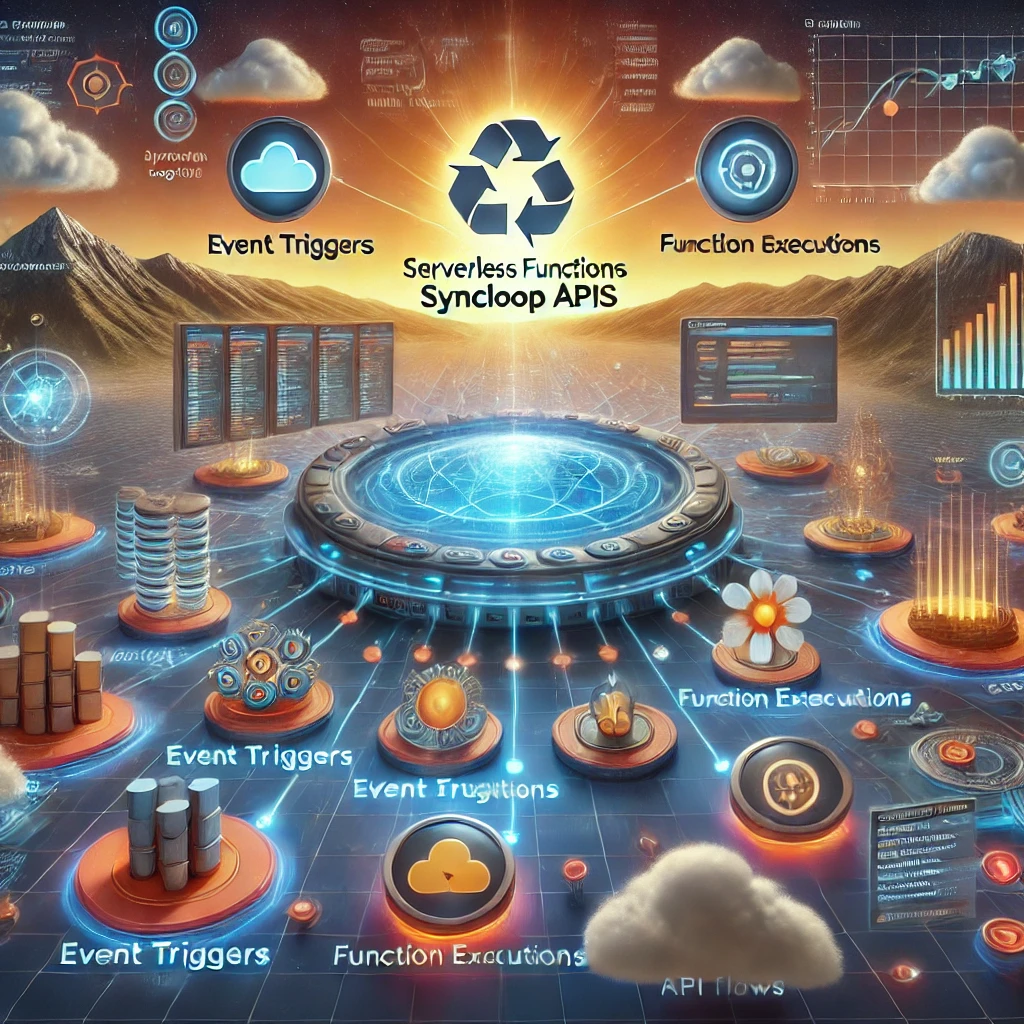Building Serverless Functions with Syncloop APIs

In this blog, we’ll explore how to build and manage serverless functions using Syncloop APIs, unlocking the potential for faster development and optimized performance.
What are Serverless Functions?
Serverless functions are lightweight, single-purpose code units executed in response to specific events or triggers. Key characteristics include:
- On-Demand Execution: Code runs only when triggered, saving resources.
- Scalability: Automatically scales based on demand.
- Cost Efficiency: Charges are incurred only for actual usage.
- Flexibility: Supports various event-driven use cases like API requests, database updates, or file uploads.
Benefits of Serverless Functions
- Reduced Infrastructure Management: No need to provision or maintain servers.
- Faster Development: Focus on writing code without worrying about the underlying architecture.
- Cost Optimization: Pay-as-you-go pricing reduces overhead for low-traffic scenarios.
- Event-Driven Architecture: Ideal for real-time applications and automation workflows.
How Syncloop Enhances Serverless Development
1. Seamless API Integration
Syncloop simplifies the integration of serverless functions with APIs, enabling developers to create event-driven workflows effortlessly.
- Features:
- Event triggers for API endpoints.
- Automatic routing of API requests to serverless functions.
- Benefits:
- Reduces development complexity.
- Speeds up the implementation of real-time workflows.
- Use Case: Triggering a serverless function to process form submissions via an API.
2. Event-Driven Architecture
Syncloop supports event-driven triggers that allow serverless functions to react to real-time changes.
- Features:
- Support for webhooks, database events, and message queues.
- Real-time execution in response to API requests.
- Benefits:
- Enables instant responses to user actions.
- Enhances application responsiveness.
- Use Case: Executing a serverless function to send email notifications upon user registration.
3. Dynamic Scaling
Syncloop automatically scales serverless functions based on demand, ensuring consistent performance.
- Features:
- Auto-scaling to handle high traffic volumes.
- Load balancing to distribute requests evenly.
- Benefits:
- Maintains performance during traffic spikes.
- Eliminates the need for manual scaling adjustments.
- Use Case: Handling bursts of traffic during a product launch.
4. Data Transformation
Syncloop enables data transformation within serverless workflows, streamlining input/output handling.
- Features:
- Pre-built tools for data formatting and mapping.
- Integration with third-party data processing platforms.
- Benefits:
- Reduces manual effort for handling complex data formats.
- Simplifies integration with external systems.
- Use Case: Transforming incoming API data into a format compatible with a legacy system.
5. Security and Access Control
Syncloop enforces robust security measures to protect serverless functions and API interactions.
- Features:
- Role-based access control (RBAC) for fine-grained permissions.
- End-to-end encryption for secure data transmission.
- Benefits:
- Safeguards sensitive data and operations.
- Ensures compliance with industry standards.
- Use Case: Protecting a serverless function that processes payment information.
6. Real-Time Monitoring
Syncloop provides tools to monitor the performance of serverless functions, enabling developers to optimize workflows.
- Features:
- Dashboards for execution times, errors, and resource usage.
- Alerts for anomalies or failures.
- Benefits:
- Enhances reliability by identifying bottlenecks quickly.
- Provides actionable insights for optimization.
- Use Case: Monitoring execution latency for a serverless function that processes image uploads.
Steps to Build Serverless Functions with Syncloop APIs
Step 1: Define the Trigger
Identify the event or API request that will trigger the serverless function, such as an HTTP request, database update, or file upload.
Step 2: Write the Function
Develop the serverless function to handle the desired task, such as data processing, notifications, or third-party API calls.
Step 3: Configure the API Endpoint
Use Syncloop to configure the API endpoint that interacts with the serverless function. This includes defining request/response formats and access controls.
Step 4: Deploy and Test
Deploy the function using Syncloop’s deployment tools and test it to ensure seamless operation and integration with APIs.
Step 5: Monitor and Optimize
Use Syncloop’s monitoring tools to track performance, identify issues, and refine the function for better efficiency.
Real-World Applications of Serverless Functions with Syncloop
1. E-Commerce
- Use Case: Automatically processing and validating orders upon API submission.
- Benefit: Real-time order handling without server overhead.
2. IoT Applications
- Use Case: Analyzing sensor data and sending alerts for abnormal readings.
- Benefit: Instantaneous responses to critical events.
3. Healthcare
- Use Case: Processing patient data uploads for real-time diagnostics.
- Benefit: Accelerates healthcare workflows with minimal latency.
4. Media and Entertainment
- Use Case: Transcoding video files upon upload to a content delivery system.
- Benefit: Enhances content availability without requiring dedicated servers.
5. Financial Services
- Use Case: Executing fraud detection algorithms for each transaction.
- Benefit: Improves security without impacting performance.
Best Practices for Serverless Development with Syncloop
- Optimize for Performance: Write lightweight, efficient functions to minimize execution times.
- Secure Your Functions: Implement RBAC and encryption to protect sensitive operations.
- Monitor Continuously: Use Syncloop’s dashboards to track performance and identify bottlenecks.
- Leverage Scalability: Take advantage of Syncloop’s auto-scaling to handle variable workloads.
- Test Extensively: Validate the function’s behavior across different scenarios and workloads.
The Future of Serverless with Syncloop
As serverless technology evolves, Syncloop is enhancing its platform with features like AI-driven performance optimization, deeper integrations with emerging cloud technologies, and advanced monitoring tools. These innovations will make serverless development even more accessible and impactful for businesses.
Conclusion
Serverless functions are transforming how applications are built and managed, offering scalability, flexibility, and efficiency. Syncloop’s comprehensive tools simplify the integration of serverless functions with APIs, enabling developers to focus on creating innovative solutions without worrying about infrastructure.
By leveraging Syncloop, businesses can build event-driven applications that are secure, responsive, and future-ready.
An illustration of a serverless workflow powered by Syncloop, showcasing event triggers, API integrations, and dynamic scaling.
Back to Blogs